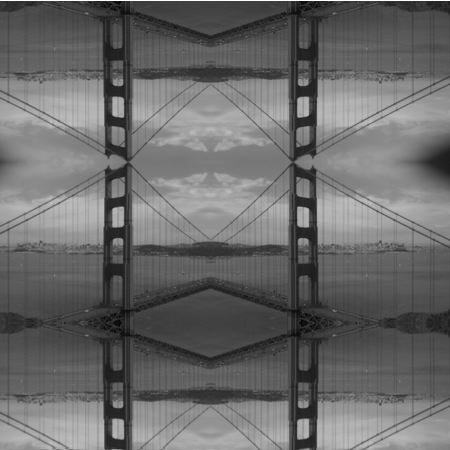Rhyme & Reason: Jude Gabbard y Muñoz responds to the Collection (Part 2)
I don’t drink coffee, so let’s have a beer … My posts are always collaborations and are presented in two parts. Part 1 is a summary of a shared experience with my collaborator(s). Part 2 is a response, often in the form of a project created specifically for this blog.

©Jude Gabbard y Muñoz
A few weeks ago I sat down with my good friend, local fashion designer Jude Gabbard. We had a great conversation that ended with a promise to do a collaborative project engaging SFMOMA’s collection. The first step was for me to choose five works from the collection. I suppose I could give my curated selection the title of Rhyme and Reason. I was specifically looking for works in a variety of media and historical periods that possess dynamic energy and/or tension, repetitive patterning, and a certain raw, cool and direct aesthetic. I asked Jude to respond to my curated group with sketches for his own visionary collection. Enjoy the multidisciplinary dialogue and check out Jude’s comments next to each of his sketches.
– Meg

Olafur Eliasson, Multiple grotto, 2004; sculpture; stainless steel, 180 in. x 180 in. x 180 in. (457.2 cm x 457.2 cm x 457.2 cm); Collection SFMOMA, Accessions Committee Fund purchase; © Olafur Eliasson

©Jude Gabbard y Muñoz
Grotto: Clothing as a function of space, it’s relationship to architecture is always in the back of my mind. The coat and dress both require creating essentially new fabrics. For the coat, flat organza formed into a few hundred little pyramids are joined together to create a new voluminous material with enough dimensionality to be remarkable. Inside I used reflective surfaces to create a deeper dimensionality, a kaleidoscopic interior that’s sheltered yet more expansive.

Josef Albers, Tenayuca, 1943; painting; oil on Masonite, 22 1/2 in. x 43 1/2 in. (57.15 cm x 110.49 cm); Collection SFMOMA, Purchase with the aid of funds from Mr. and Mrs. Richard N. Goldman and Madeleine Haas Russell; © The Josef and Anni Albers Foundation / Artists Rights Society (ARS), New York

©Jude Gabbard y Muñoz
Tenayuca: Mexico has had as much influence defining modernity as it has primitivism. The interplay between gauzy layers and sharp hard forms are two concepts that seem completely at odds; but visually they create a dynamic tension that is nearly impossible to express with words.

Franz Marc, Gebirge (Mountains) formerly Landschaft (Landscape), 1911-1912; painting; oil on canvas, 51 1/2 in. x 39 3/4 in. (130.81 cm x 100.97 cm); Collection SFMOMA, Gift of the Women’s Board and Friends of the Museum”

©Jude Gabbard y Muñoz
Giberge: The overlap of Sonia Delauney’s work with that of Franz Marc was a real inspiration. Delauney is the owner of Simultaneity in fashion, but her clothes often look bulky and heavy. I tried here to lighten the mood, maintaining the same pulsating use of color while using applique technique to create a more layered effect, the way Franz Marc does so skillfully.

E. & H.T. Anthony & Co., Suspension Bridge Carriage Way, Perspective View, ca. 1890s; photograph; albumen stereograph, 3 1/4 in. x 6 3/4 in. (8.26 cm x 17.15 cm); Collection SFMOMA, Gift of Gordon L. Bennett

©Jude Gabbard y Muñoz, Suspension Bridge textile design TM
Suspension Bridge: The merging of architecture, engineering and fine art is sort of fantastic. Dress is really about creating little architectural spaces, portable paintings in a way. They’re almost little museums. Computer generated designs, like photography in the 19th c is just coming into common usage. The object as accidental art was my starting point here.

Suspension Bridge fabric detail: The idea of merging technology with handcraft. In the time of E. and H.T. Anthony society looked to technology to save them from a life of drudgery and discomfort. In our time people are looking towards handcraft and primitivism to save us from the alienating crush of technology. An everyday object redefined as something totemic or fetishistic.

Giovanni Anselmo, Grigi che si alleggeriscono verso oltremàre (Grays Lightening toward…), 1988; sculpture; stone, steel cable, slipknot, and ultramarine blue pigment, 108 in. x 240 in. x 24 in. (274.32 cm x 609.6 cm x 60.96 cm); Collection SFMOMA, Accessions Committee Fund: gift of Frances and John G. Bowes, Harriet G. Henderson, Helen and Charles Schwab, and Phyllis and Stuart Moldaw; © Giovanni Anselmo

©Jude Gabbard y Muñoz
Ultramarine Landscape: Found and vintage objects/materials are often included in my work. The redingote is a classic piece of traveling attire for horses and later cars. Here it’s reinterpreted with Arte Povera elements. I’ve played off the themes of travel and the sea both with the forms and construction. I’ve also recreated the interplay of light and heavy with the mixture of textiles. I thought of doing something conceptual here like Christo’s Wedding Dress but I thought people would be more interested in seeing a more wearable interpretation.
Comments (2)
A wonderful, synergisitic work flow. Sonia Delauney is one of our sources of inspiration so it was particularly interesting to see your hybrid take. We are actually in the market for a designer for our forthcoming production….Meg knows where to find us!
Meg that’s a great post! I like Jude’s ideas and how he blends the abstract with the utilitarian. I also like that these are all whole ideas, not just fragments and bits of something. This work reminds me of the fashion movements during the Russian Revolution when the artists wanted to design beautiful and attractive garments for the workers. The assumption was that just because workers and peasants were poor it didn’t mean they had to dress in drab, poorly designed clothing.
I guess it was part of their utopian ambitions….